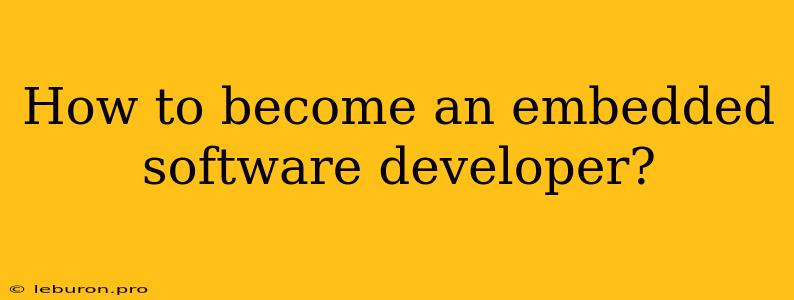Embarking on a career as an embedded software developer opens doors to a world of innovation and problem-solving, where you can bring digital intelligence to the physical world. This field is constantly evolving, demanding professionals with a unique blend of software development expertise and a deep understanding of hardware systems. If you're intrigued by the prospect of building the brains behind smart devices, this guide will equip you with the essential knowledge and steps to become an embedded software developer.
Understanding the Embedded World
Embedded software developers are the architects of the invisible intelligence that drives the devices we use every day. From the sleek touchscreens of smartphones to the intricate control systems in cars, medical equipment, and industrial machinery, embedded software is the unseen force that makes it all work.
What is Embedded Software?
Embedded software refers to software specifically designed and written to control the functions of a particular device or system. Unlike general-purpose software that runs on personal computers, embedded software is tightly integrated with the hardware it operates. This close interaction requires developers to understand the intricacies of both the software and hardware components.
Why Choose Embedded Software Development?
-
High Demand: The growing Internet of Things (IoT) and the increasing complexity of devices are driving a significant demand for skilled embedded software developers.
-
Diverse Applications: This field offers a wide range of opportunities across various industries, including consumer electronics, automotive, healthcare, aerospace, and more.
-
Problem-Solving Challenges: Embedded software development involves solving complex technical challenges, making it intellectually stimulating and rewarding.
-
Real-World Impact: You'll contribute to the development of products that directly impact people's lives, from improving healthcare technology to enhancing automotive safety.
Essential Skills for Success
Becoming a proficient embedded software developer requires a combination of technical skills, problem-solving abilities, and a strong understanding of the embedded ecosystem.
1. Programming Languages:
- C and C++: These are the most popular languages in embedded development due to their efficiency, direct hardware access, and performance.
- Assembly Language: Understanding assembly language is beneficial for optimizing code performance and interacting directly with hardware.
- Python: Python is increasingly used for scripting, prototyping, and rapid development in embedded systems.
2. Hardware Fundamentals:
- Microcontrollers and Microprocessors: Understanding the architecture, memory organization, and peripherals of these devices is crucial.
- Digital Electronics: Familiarity with logic gates, digital circuits, and communication protocols is essential for interfacing with hardware.
- Analog Electronics: Some embedded systems require knowledge of analog circuits and sensors.
3. Real-Time Operating Systems (RTOS):
- RTOS Concepts: RTOS are specialized operating systems optimized for embedded applications. Understanding their concepts, scheduling, and communication mechanisms is vital.
- Common RTOS: Familiarize yourself with popular RTOS like FreeRTOS, Zephyr, and μC/OS-II.
4. Communication Protocols:
- Serial Communication (UART, SPI, I2C): These protocols enable communication between different components within a system.
- Network Communication (TCP/IP, UDP): For embedded systems that need to connect to networks, understanding network protocols is essential.
5. Debugging and Testing:
- Debugging Tools: Proficiency in using debuggers, emulators, and logic analyzers is crucial for identifying and resolving software issues.
- Testing Techniques: Understanding different testing methods, including unit testing, integration testing, and system testing, is important for ensuring software quality.
6. Continuous Learning:
The embedded software development landscape is constantly evolving. Staying updated with new technologies, languages, and tools is vital for professional growth.
The Pathway to Becoming an Embedded Software Developer
1. Education and Training:
- Computer Science or Electrical Engineering Degree: A solid foundation in computer science, electrical engineering, or a related field is highly recommended.
- Specialized Embedded Systems Courses: Consider taking courses that focus on embedded systems, microcontrollers, and real-time operating systems.
- Online Courses and Certifications: Platforms like Coursera, edX, and Udemy offer a wide range of courses and certifications related to embedded software development.
2. Hands-on Experience:
- Personal Projects: Start building your own embedded projects using development boards like Arduino, Raspberry Pi, or STM32.
- Internships and Part-Time Jobs: Gaining practical experience through internships or part-time jobs can accelerate your learning process and expose you to real-world challenges.
- Open-Source Projects: Contributing to open-source embedded software projects can provide valuable learning opportunities and network with experienced developers.
3. Building Your Portfolio:
- Showcasing Projects: Create a portfolio of projects that demonstrate your skills and highlight your accomplishments in embedded software development.
- GitHub Repository: Use GitHub to host your code and share it with potential employers.
4. Networking and Community Involvement:
- Industry Events and Conferences: Attending embedded systems conferences and workshops can keep you up-to-date with industry trends and connect you with professionals.
- Online Forums and Communities: Engage with other embedded developers through online forums, discussion groups, and social media platforms.
Conclusion
Embarking on a career as an embedded software developer requires a commitment to continuous learning, hands-on experience, and a passion for technology. By mastering the essential skills, pursuing relevant education, and actively engaging in the embedded community, you can equip yourself for a rewarding and impactful career in this rapidly evolving field. As the world becomes increasingly interconnected and intelligent, the role of embedded software developers will only continue to grow in significance, offering exciting opportunities for innovation and problem-solving in the years to come.
